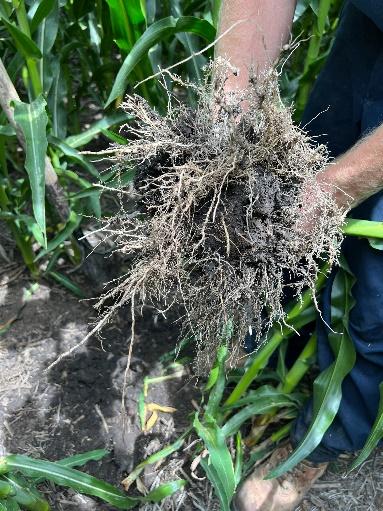EARLY SEASON ISSUES COULD HAVE END-OF-SEASON IMPLICATIONS
Dryness and potassium deficiency at critical times early in the growing season could leave some of Iowa’s corn crop vulnerable this fall.
While recent rains have eased some of the drought stress for corn farmers in southern Iowa, AgriGold Agronomist Emily Prevo warns they are not out of the woods yet. Nutrient deficiencies – of potassium (K), in particular – along with root constriction could cause problems for those farmers this fall.
DROUGHT AND SOIL COMPACTION FUEL POTASSIUM DEFICIENCY
“Roots have a harder time pulling up potassium when soils are dry,” Prevo explains, noting that her area was gripped by drought during the V6 to silking period of peak potassium usage. While farmers may have had enough potassium in the soil, it wasn’t accessible to the plant.

“Tomahawked” or “hatchet” roots added to the problem. A three-week cooldown after planting during which some areas received no rain and others received too much rain caused soil crusting, sidewall compaction and a tight soil profile. The resulting root constriction compounded nutrient constriction.
“The role of potassium in the plant is to open and close the millions of pore-like structures in the leaves known as stomata that let water in and out, helping with energy production and moving water and protein through that plant,” Prevo explains. “But when potassium availability is restricted, those stomata don’t work as efficiently.”
Unfortunately, remedies for dryness-related potassium deficiencies are limited. “I would love to say there is an easy fix or solid rescue strategy, but a good rain is about your best bet,” Prevo says. In normal years, farmers should make sure to have enough potassium upfront, she adds.
“Field GX™ Family F products appeared to handle these environments well versus other genetic families thanks to its fibrous root system,” says AgriGold Agronomist Kevin Gale. “These roots typically are more prolific and can access additional nutrients in stressful environments.”
AgriGold agronomists classify their hybrids into families based on agronomic traits. This approach helps farmers understand performance outcomes and the best management strategies for each product.
POTASSIUM DEFICIENCIES TEND TO COINCIDE WITH OTHER ISSUES
It’s often said when you have a potassium deficiency, nitrogen deficiency will also show up, according to Prevo. That held true in her area of southern Iowa this season.
Stalk viability is another concern for Prevo. “As we entered key points of the growing season, we already had compromised root systems, and with the added drought stress stalk strength declines,” she points out. “A wind event, wet weather or lodging could threaten yields this fall.”
With that in mind, she says, “This is not the season to sit back and wait for perfect harvest conditions. Prioritize fields and be ready to roll.”
DETECTING A NUTRIENT DEFICIENCY
“I encourage farmers to get in the fields and dig roots to assess root structure,” Prevo says. Telltale symptoms of potassium deficiency include yellowing or necrosis that starts with the tips of the lower leaves and slowly works its way along the outer edge of the leaf toward the base. That contrasts with nitrogen deficiency, which causes an inverted V down the middle of the plant.
Testing can also help farmers detect nutrient deficiencies so they can adjust for seasons to come. For potassium, a soil test can indicate whether the deficiency stems from dryness or the soil fertility level itself, Prevo says, emphasizing the importance of testing on a consistent basis.
“Tissue sampling is another option and is one of the best ways of seeing what is actually getting pulled up into the plant versus what’s in the soil,” Prevo continues. The AgriGold process takes six tissue samples at precise points in the growing season based on growing degree units, giving agronomists and farmers a season-long take rather than a single moment in time. They can use that to remedy dips, imbalances and shortfalls in nutrient management.
If you’re interested in tissue sampling or any additional support getting the most out of your crops, reach out to your local AgriGold agronomist.



